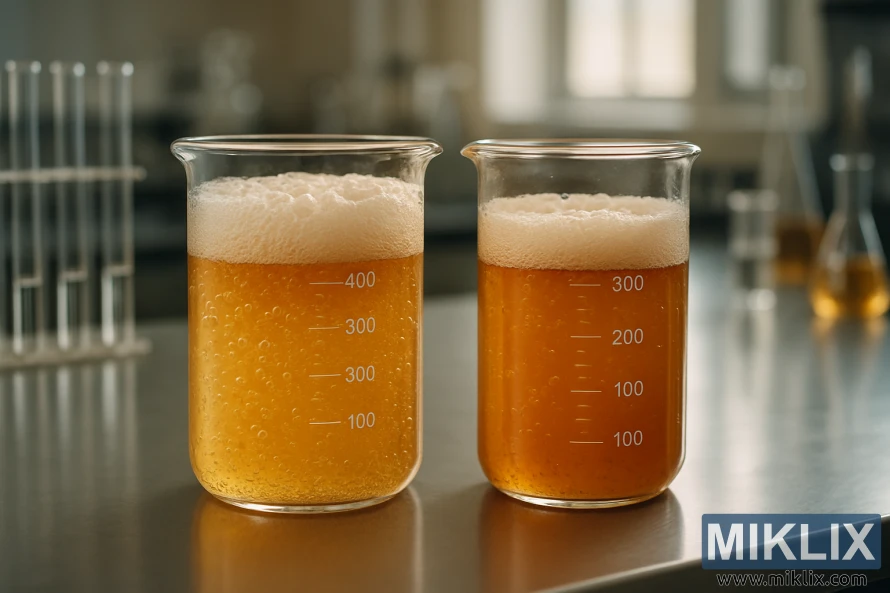Image: Comparison of Two Yeast Strains
Published: July 25, 2025 at 7:55:05 AM UTC
Last updated: September 27, 2025 at 10:14:42 PM UTC
Laboratory scene with two beakers of bubbly, fermenting yeast, highlighting differences between strains under warm, natural lighting.
This image captures a moment of focused experimentation within a modern fermentation laboratory, where the subtle nuances of yeast behavior are being carefully observed and compared. At the heart of the composition are two transparent glass beakers, each filled with a golden, effervescent liquid that glows under the soft, natural lighting. The liquids are visibly fermenting—fine streams of bubbles rise steadily from the bottom of each beaker, forming delicate foam caps at the surface. These bubbles are not merely aesthetic; they are the visible breath of yeast cells metabolizing sugars into alcohol and carbon dioxide, a process that is both ancient and scientifically rich.
The beakers are marked with precise measurement lines, up to 400 milliliters, suggesting that this is not a casual setup but a controlled experiment. The beaker on the left contains slightly more liquid and a thicker foam layer than the one on the right, hinting at differences in yeast strain, fermentation kinetics, or nutrient composition. These subtle visual contrasts invite the viewer to consider the variables at play—perhaps one strain is more vigorous, producing more gas and foam, while the other is slower, more restrained, or operating under slightly different conditions. The clarity of the liquid, the density of the bubbles, and the texture of the foam all serve as clues in this ongoing investigation.
Surrounding the beakers is a sleek, stainless steel counter, its reflective surface catching the ambient light and adding a sense of cleanliness and precision to the scene. Scattered across the counter are additional pieces of laboratory glassware—test tubes, flasks, and pipettes—each one clean and ready for use. These tools suggest a workflow that includes sampling, measuring, and possibly microscopic analysis, reinforcing the idea that this is a space where brewing meets biology. The arrangement is orderly but not sterile, conveying a sense of active engagement and thoughtful inquiry.
The lighting in the room is warm and natural, likely filtered through a nearby window, casting gentle shadows and enhancing the golden tones of the fermenting liquids. This illumination adds depth and warmth to the scene, making it feel both professional and inviting. It highlights the textures of the foam, the shimmer of the bubbles, and the subtle differences between the two beakers, guiding the viewer’s eye and encouraging close observation.
In the background, hints of additional equipment and shelving are softly blurred, maintaining focus on the beakers while providing context. The muted backdrop suggests a well-equipped lab, where fermentation is studied not just for production but for understanding. It evokes a mood of quiet concentration, where each experiment is a step toward deeper knowledge and better outcomes.
Altogether, the image conveys a narrative of scientific exploration and artisanal care. It celebrates the complexity of yeast, the importance of controlled conditions, and the beauty of fermentation as both a biological process and a craft. Through its composition, lighting, and detail, the image invites the viewer to appreciate the subtle differences between yeast strains and the meticulous work required to unlock their full potential. It is a portrait of brewing as a discipline rooted in observation, experimentation, and the pursuit of excellence.
The image is related to: Fermenting Beer with CellarScience German Yeast

